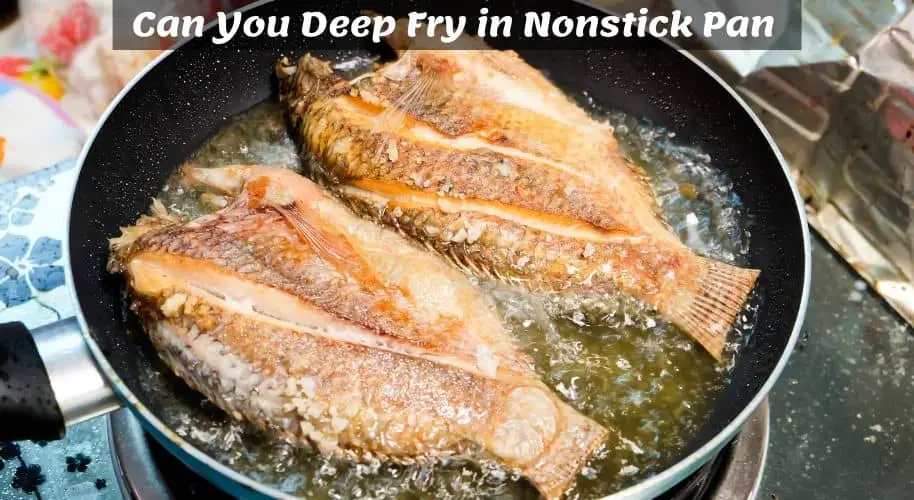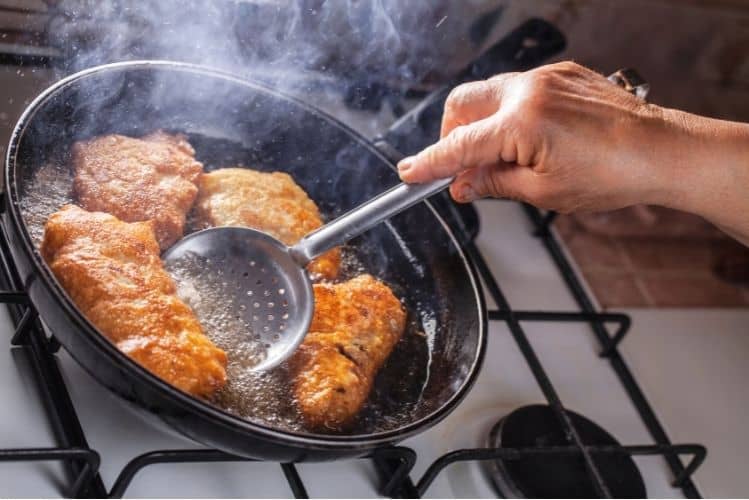Nonstick pans can be used in a variety of ways. They’re great for frying eggs, sautéing vegetables, and making classic pancakes. However, the incorrect cookware for a particular dish can damage the texture and flavor of the dish.
For instance, cooking experts have differing views on deep-frying in nonstick pans. Some chefs are opposed to deep frying on a nonstick pan, while others believe it is safe if certain measures are taken. In this basic guide, we’ll address the question “can you deep fry in nonstick pan” with a comprehensive analysis of deep frying in a nonstick pan. Let’s see if nonstick pans are suitable for deep frying.

What Exactly Is Nonstick Coating?
Cookware with non-stick coatings is meant to make cleaning easier. Teflon is commonly utilized. However, other non-stick materials are also employed, such as PFOA (Perfluorochemicals). The main argument is that they are less risky than their traditional equivalents, but are they really? Isn’t it especially true when you’re deep-frying in them? Let’s see!
Also read: What does pfoa free mean
Is it Possible to Deep-Fry in a Nonstick Pan?
You can absolutely deep fry in a non-stick pan on occasion, given the versatility of non-stick cookware. For frequent deep frying, you can use stainless steel, cast iron, or copper pans. When it comes to deep-frying, why is stainless steel or conventional cookware the first choice? The answer is that when you deep fry, things get incredibly hot.
Cast iron or stainless steel pans are built to withstand high temperatures while avoiding the health risks connected with non-stick pans. Stainless steel, cast iron, or copper are safer options that assure even heating and eliminate any risk.
Things To Keep In Mind When Deep Frying in a Nonstick Pan

When deep-frying in a nonstick pan, there are specific general guidelines to follow to guarantee that you don’t damage your pan and that your food comes out excellent. The best practices to follow are:
Avoid Using Shallow Pans
Because non-stick pans are often shallow, deep frying in them with a significant amount of oil can soon become dangerous, as a little knock could spill the entire batch of oil onto you. Oil can easily exceed the temperature of boiling water, reaching 450 degrees Fahrenheit in extreme cases, but water only reaches 212 degrees Fahrenheit.
That means that if you spill a vat of 450°F oil on yourself, it could result in a potentially fatal situation. Even if it doesn’t hit you, there’s a good potential that big amounts of cooking oil will leak and cause a fire in your kitchen. As a result, if you’re going to deep fry in a non-stick pan, choose one with depth, such as a saucepan. Also, avoid filling it to the brim.
Keep the Nonstick Coating From Melting
One of the primary issues with deep frying in non-stick pans is the non-stick coating, which, as everyone knows, can melt at high temperatures, resulting in toxicity. Is it, therefore, safe to deep fry? Yes, deep-frying with nonstick pans is safe, but you must keep the oil from becoming too hot. Although PTFE has a melting point of roughly 620 degrees Fahrenheit, this does not mean you should allow your pan to reach that temperature.
Teflon recommends not exceeding 500 degrees Fahrenheit. The simplest approach to keep the pan from becoming too hot is to purchase an infrared thermometer, which can be used to monitor the temperature of the oil and the pan to ensure that neither of them overheats.
Pick the Best Cooking Oil
When picking an oil for non-stick pans, look for one with a high smoke point since this will prevent the oil from burning and reacting with the Teflon covering. However, you’ll also require an unflavored cooking oil. After all, you don’t want the flavor of your dish to suffer and make the food unpleasant. Let’s have a look at the best oil options!
Grapeseed Oil
It is a fantastic oil to use. It has a consistent smoke point of 240 degrees Fahrenheit, which is ideal for nonstick pans. Grapeseed oil is low in saturated fats and nearly cholesterol-free. It’s a flavorless oil that you can use in place of canola oil.
You can also use Grape seed oil to fry items like French fries and churros. The oil will stay hotter for a longer period of time, which is ideal for crispy fried dishes. The oil will not break down or develop a poor taste no matter how long you use it for deep frying.
Moreover, it’s possible that grapeseed oil isn’t as stable as soybean or maize oil. It does, however, have the healthiest fats. You can eat deep-fried dishes without feeling guilty!
Canola Oil
At high temperatures, canola oil remains stable. Canola oil is good for deep frying because it has a smoke point of 207 degrees Celsius. It’s also abundant in heart-healthy omega fatty acids and low in saturated fats. As a result, it’s a good choice for deep frying.
The stability of canola oil makes it ideal for nonstick pans. Low-smoke-point oils may react with the Teflon coating. Teflon is generally stable at temperatures of 260 degrees Fahrenheit. However, if the temperature rises above this point, the coating may begin to fail.
Canola oil can maintain a constant temperature on the cooking surface. It provides just the right amount of heat without harming the Teflon covering. This is a crucial consideration to keep in mind. If the nonstick coating fails, hazardous substances may be released into the air. These gases can cause Teflon flu and are very dangerous to your health.
Peanut Oil
Peanut oil is another excellent option for deep-frying on nonstick pans. At 232 degrees Celsius, this oil has a relatively stable and high smoke point. It’s nearly identical to sunflower oil, making it a good deep-frying substitute.
Although peanut oil isn’t a common choice, it’s one of the healthiest deep-frying oils available. As the oil has a neutral flavor, it will not alter the flavor of the fried foods. Peanut oil is high in healthy fats, making it an excellent substitute for lard and shortening.
It won’t react with the nonstick coating because it’s a stable oil. Rather, the oil will form a seasoning layer on top of your nonstick pan, which will protect it. Make sure, however, that you’re using the refined variety. Cold-pressed peanut oil has a distinct flavor. This is due to the possibility that peanut proteins will seep into the oil during the frying process.
Don’t Preheat the Skillet
When deep-frying, you should avoid preheating your pan. Preheating is a no-no since it jeopardizes the non-stick coating. The reason for this is that the high temperature of the pan without any oil in it may cause some patches on the nonstick surface of your pan to dry and flake off.
As a result, it creates a tiny scratch that could split and form a hole in the surface if it is contacted by oil or food particles. This means that after just one use of preheating the pan, the non-stick coating has worn away. So please don’t do that! Until you’re ready to start cooking, let your covered cookware alone.
Don’t Deep Fry on a High Heat
Deep frying is not difficult, but you must be careful to avoid any mishaps or burned food. Deep frying should never be done at temperatures above 392°F (200°C). High heat will not only burn your food before it can become crispy, but it will also cause the Teflon coating to begin to break down into your meal.
Make Use of the Proper Cooking Tools
When using your non-stick pan, make sure you use the right cooking utensils for the job. This means that no metal or plastic utensils should be used. While deep frying, metal utensils will most likely scratch the Teflon covering off the pan, and plastic will most likely melt. Instead, when deep frying in a nonstick pan, silicone or wooden cooking tools are the best option.
What Are the Best Deep Frying Nonstick Pans?
Due to changes in material, weight, coating, and size, different nonstick pans are available on the market. Deeper and larger pans with a heavyweight are often preferred for deep frying over others. The larger surface area of the broader pans allows the oil to heat up quickly and the food to cook fast. In such pans, the heat is also well-maintained during the cooking process. The deeper pans prevent the oils from leaking or bouncing out of the pans. You can get some ideas by following the link.
Cast iron is a wonderful alternative when it comes to non-stick qualities. Cast iron is a highly stable, long-lasting, and efficient heat conductor. These pans are large and hefty, allowing you to fry meals fast and efficiently. Meanwhile, stainless steel pans with aluminum or copper bases are another option because they are affordable and nonreactive to the meals placed in them.
Conclusion
Thanks for reading this guide. Here, we’ve already answered the question “can you deep fry in a nonstick pan?” by going over the pros and cons of deep frying in a nonstick pan. You’ve also learned which nonstick pans are excellent for deep frying, which oils are best for frying in nonstick pans, what to keep in mind when deep frying in nonstick pans, and what nonstick pan alternatives are available. We hope you’ve found this guide helpful and informative.
Please share this information with your friends and family – let them know that it’s never been easier to fry up their favorite foods!
Sharing is caring!
My name is Lori Walker. I’m a registered dietitian, food blogger and food enthusiast. I share easy healthy, delicious recipes on my blog and review necessary kitchen items. The recipes I share take less… Read more
